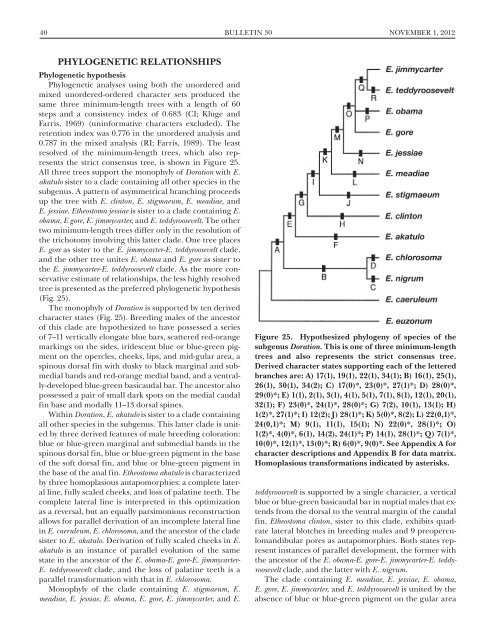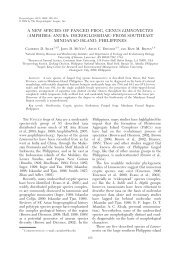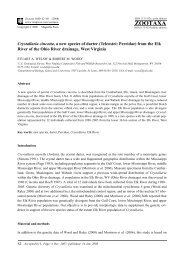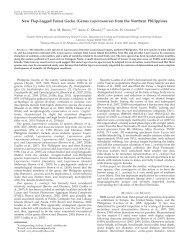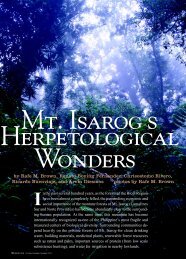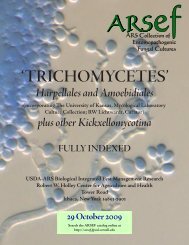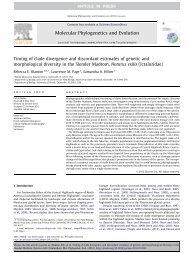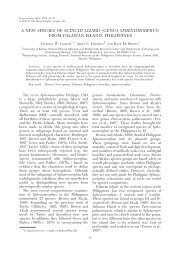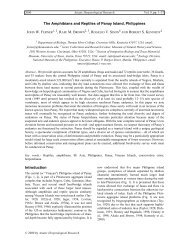(Percidae: Etheostoma), with Descriptions of Five New Species
(Percidae: Etheostoma), with Descriptions of Five New Species
(Percidae: Etheostoma), with Descriptions of Five New Species
- No tags were found...
You also want an ePaper? Increase the reach of your titles
YUMPU automatically turns print PDFs into web optimized ePapers that Google loves.
40 Bulletin 30 NOVEMBER 1, 2012PHYLOGENETIC RELATIONSHIPSPhylogenetic hypothesisPhylogenetic analyses using both the unordered andmixed unordered-ordered character sets produced thesame three minimum-length trees <strong>with</strong> a length <strong>of</strong> 60steps and a consistency index <strong>of</strong> 0.683 (CI; Kluge andFarris, 1969) (uninformative characters excluded). Theretention index was 0.776 in the unordered analysis and0.787 in the mixed analysis (RI; Farris, 1989). The leastresolved <strong>of</strong> the minimum-length trees, which also representsthe strict consensus tree, is shown in Figure 25.All three trees support the monophyly <strong>of</strong> Doration <strong>with</strong> E.akatulo sister to a clade containing all other species in thesubgenus. A pattern <strong>of</strong> asymmetrical branching proceedsup the tree <strong>with</strong> E. clinton, E. stigmaeum, E. meadiae, andE. jessiae. <strong>Etheostoma</strong> jessiae is sister to a clade containing E.obama, E gore, E. jimmycarter, and E. teddyroosevelt. The othertwo minimum-length trees differ only in the resolution <strong>of</strong>the trichotomy involving this latter clade. One tree placesE. gore as sister to the E. jimmycarter-E. teddyroosevelt clade,and the other tree unites E. obama and E. gore as sister tothe E. jimmycarter-E. teddyroosevelt clade. As the more conservativeestimate <strong>of</strong> relationships, the less highly resolvedtree is presented as the preferred phylogenetic hypothesis(Fig. 25).The monophyly <strong>of</strong> Doration is supported by ten derivedcharacter states (Fig. 25). Breeding males <strong>of</strong> the ancestor<strong>of</strong> this clade are hypothesized to have possessed a series<strong>of</strong> 7–11 vertically elongate blue bars, scattered red-orangemarkings on the sides, iridescent blue or blue-green pigmenton the opercles, cheeks, lips, and mid-gular area, aspinous dorsal fin <strong>with</strong> dusky to black marginal and submedialbands and red-orange medial band, and a ventrally-developedblue-green basicaudal bar. The ancestor alsopossessed a pair <strong>of</strong> small dark spots on the medial caudalfin base and modally 11–13 dorsal spines.Within Doration, E. akatulo is sister to a clade containingall other species in the subgenus. This latter clade is unitedby three derived features <strong>of</strong> male breeding coloration:blue or blue-green marginal and submedial bands in thespinous dorsal fin, blue or blue-green pigment in the base<strong>of</strong> the s<strong>of</strong>t dorsal fin, and blue or blue-green pigment inthe base <strong>of</strong> the anal fin. <strong>Etheostoma</strong> akatulo is characterizedby three homoplasious autapomorphies: a complete lateralline, fully scaled cheeks, and loss <strong>of</strong> palatine teeth. Thecomplete lateral line is interpreted in this optimizationas a reversal, but an equally parsimonious reconstructionallows for parallel derivation <strong>of</strong> an incomplete lateral linein E. caeruleum, E. chlorosoma, and the ancestor <strong>of</strong> the cladesister to E. akatulo. Derivation <strong>of</strong> fully scaled cheeks in E.akatulo is an instance <strong>of</strong> parallel evolution <strong>of</strong> the samestate in the ancestor <strong>of</strong> the E. obama-E. gore-E. jimmycarter-E. teddyroosevelt clade, and the loss <strong>of</strong> palatine teeth is aparallel transformation <strong>with</strong> that in E. chlorosoma.Monophyly <strong>of</strong> the clade containing E. stigmaeum, E.meadiae, E. jessiae, E. obama, E. gore, E. jimmycarter, and E.Figure 25. Hypothesized phylogeny <strong>of</strong> species <strong>of</strong> thesubgenus Doration. This is one <strong>of</strong> three minimum-lengthtrees and also represents the strict consensus tree.Derived character states supporting each <strong>of</strong> the letteredbranches are: A) 17(1), 19(1), 22(1), 34(1); B) 16(1), 25(1),26(1), 30(1), 34(2); C) 17(0)*, 23(0)*, 27(1)*; D) 28(0)*,29(0)*; E) 1(1), 2(1), 3(1), 4(1), 5(1), 7(1), 8(1), 12(1), 20(1),32(1); F) 23(0)*, 24(1)*, 28(0)*; G) 7(2), 10(1), 13(1); H)1(2)*, 27(1)*; I) 12(2); J) 28(1)*; K) 5(0)*, 8(2); L) 22(0,1)*,24(0,1)*; M) 9(1), 11(1), 15(1); N) 22(0)*, 28(1)*; O)1(2)*, 4(0)*, 6(1), 14(2), 24(1)*; P) 14(1), 28(1)*; Q) 7(1)*,10(0)*, 12(1)*, 13(0)*; R) 6(0)*, 9(0)*. See Appendix A forcharacter descriptions and Appendix B for data matrix.Homoplasious transformations indicated by asterisks.teddyroosevelt is supported by a single character, a verticalblue or blue-green basicaudal bar in nuptial males that extendsfrom the dorsal to the ventral margin <strong>of</strong> the caudalfin. <strong>Etheostoma</strong> clinton, sister to this clade, exhibits quadratelateral blotches in breeding males and 9 preoperculomandibularpores as autapomorphies. Both states representinstances <strong>of</strong> parallel development, the former <strong>with</strong>the ancestor <strong>of</strong> the E. obama-E. gore-E. jimmycarter-E. teddyrooseveltclade, and the latter <strong>with</strong> E. nigrum.The clade containing E. meadiae, E. jessiae, E. obama,E. gore, E. jimmycarter, and E. teddyroosevelt is united by theabsence <strong>of</strong> blue or blue-green pigment on the gular area


